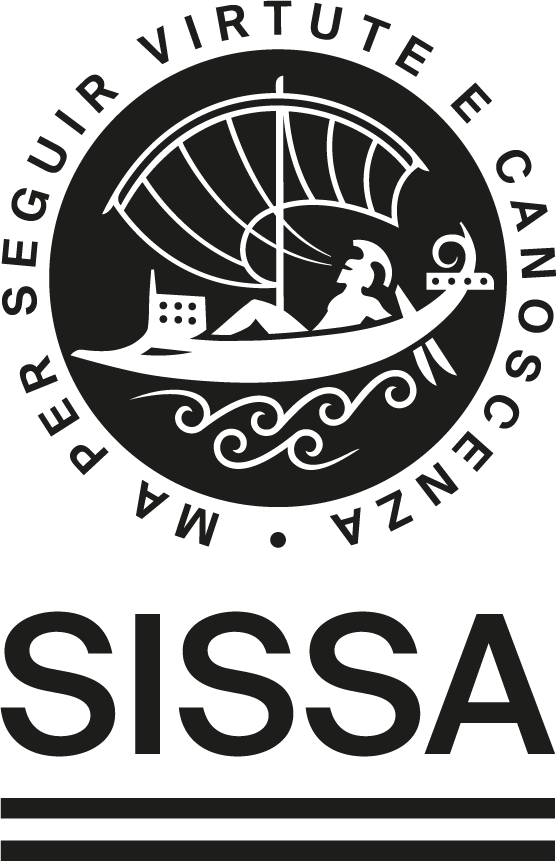When: Tuesday, 15th May, 2018
Where: SISSA, First Floor, Room 128-129
| 10:30–11:20 | Discussions | |
|---|---|---|
| 11:20–11:55 | Alvise Bastianello | |
| From relativistic to non-relativistic integrable models | ||
| 11:55–12:30 | Tiago Mendes-Santos | |
| Entanglement Hamiltonians of lattice models via Bisognano–Wichmann theorem | ||
| 12:30–13:30 | Lunch | |
| 13:30–15:15 | Discussions | |
| 15:15–15:50 | Bruno Bertini | |
| Exact Spectral Form Factor in a Minimal Model of Many-Body Quantum Chaos | ||
| 15:50–16:00 | Break | |
| 16:00–17:00 | Giulio Biroli | |
| Energy Landscape and Training Dynamics of Deep Neural Networks | ||
| 17:00– | Discussions | |
Speaker: Alvise Bastianello
Abstract: Integrable models are ubiquitous in physics, from high energy research down to low energy phenomena, which find experimental realizations in the cold atoms’ world.
New experiments caused an outburst of efforts by theoretical physicists in understanding equilibrium and out-of-equilibrium features of these models, with a wide variety in the techniques used. In particular, relativistic integrable models can be tackled by means of relativistic invariance conjoint with crossing symmetry, laying the foundation for the celebrated bootstrap approach.
In this talk I take advantage of the available results in relativistic integrable models to shade new light in the non-relativistic realm, through a proper non-relativistic limit. The first part of the talk is dedicated to understanding which kind of non-relativistic models can be reached through the mentioned limit, discovering that we get essentially the well known Lieb Liniger model and generalization thereof.
In the second part, I present new exact results concerning the one point functions in the Lieb Liniger model, obtained from available formulas in the Sinh Gordon model.
References:
A. Bastianello, A. De Luca, G. Mussardo, J. Stat. Mech. 2016 (12), 123104
A. Bastianello, A. De Luca, G. Mussardo, J. Phys. A 50 (23), 234002 (2017)
A. Bastianello, L. Piroli, P. Calabrese, Phys. Rev. Lett. 120, 190601 (2018)
Speaker: Tiago Mendes-Santos
Abstract: The modular (or entanglement) Hamiltonian (EH) of a quantum system provides an alternative way to uniquely characterize its entanglement properties. In particular, an appealing fact is that the ground state entanglement entropy is directly related to the thermodynamic entropy of the EH. However, in the context of lattice models, the explicit form of the EH is analytically known just for the quantum Ising model. On the other hand, a closed form of the modular EH is provided by the Bisognano-Wichmann (BW) for quantum field theory. Here we explore the lattice version of this theorem to construct the entanglement Hamiltonian for a variety of lattice models, supporting diverse quantum phases and critical points, and scanning several universality classes, including Ising, Potts, and Luttinger liquids. Extensive numerical simulations based on density matrix renormalization group, exact diagonalization, and quantum Monte Carlo, are then used to provide a comparison between exact results and the lattice version of BW theorem. Our results provide evidence that the lattice EH is close to the BW one. In particular, we show that the entanglement entropy obtained via the BW theorem properly decribes universal properties in both one- and two- dimensional lattice models.
Speaker: Bruno Bertini
Abstract: The most general and versatile defining feature of quantum chaotic systems is that they possess an energy spectrum universally described by random matrix theory (RMT). This feature can be exhibited by systems with a well defined classical limit as well as by systems with no classical correspondence, such as locally interacting spins or fermions. Despite great phenomenological success, a general mechanism explaining the emergence of RMT without reference to semiclassical concepts is still missing. In this talk I will present exact analytical results for the energy spectrum of the Floquet propagator of the kicked Ising spin-1/2 chain with longitudinal and transverse fields. Specifically, I will show that the Fourier transform of spectral density’s two-point function, the spectral form factor, can be written in terms of a partition function of a two-dimensional classical Ising model featuring a space-time duality. The self-dual cases provide a minimal model of many-body quantum chaos, where the spectral form factor matches RMT for all values of the integer time variable t in the thermodynamic limit. In particular, RMT behaviour is rigorously proved for odd t, while I formulate a precise conjecture for even t. These results imply ergodicity for arbitrary finite amount of disorder in the longitudinal field, rigorously excluding the possibility of many-body localization.
Reference:
B. Bertini, P. Kos, and T. Prosen, arXiv:1805.00931

